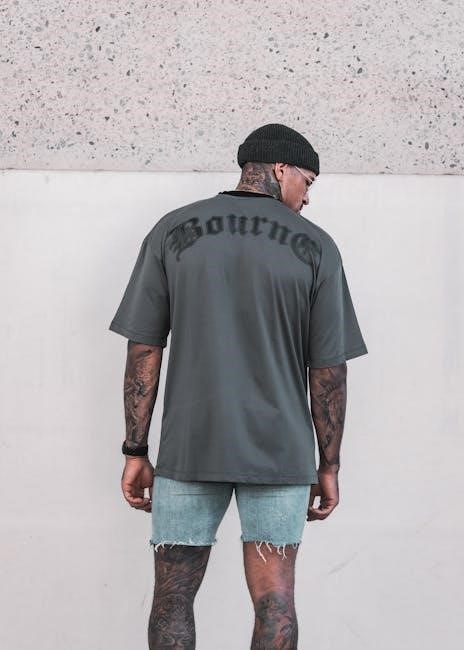men’s shirt size guide australia
Understanding men’s shirt sizes in Australia is essential for ensuring comfort and style․ Sizes are based on body measurements, including neck, chest, and waist circumferences in centimeters․
Overview of Men’s Shirt Sizes in Australia
Men’s shirt sizes in Australia are typically categorized into standard sizes such as Small, Medium, Large, and Extra-Large, with some brands offering extended sizes like XXL or 5XL․ These sizes are based on body measurements, including neck, chest, and waist circumferences, usually measured in centimeters․ For example, a Medium size might correspond to a neck measurement of 38-40 cm, a chest measurement of 96-102 cm, and a waist measurement of 80-84 cm․ Sizes can vary slightly between brands, so it’s important to refer to specific size charts for accurate fitting․ Most brands provide detailed charts to help consumers determine their best fit based on their measurements․ This ensures a comfortable and stylish wear, whether for casual or formal occasions․
Why Understanding Shirt Sizes is Important
Understanding shirt sizes is crucial for ensuring both comfort and style․ A well-fitting shirt enhances confidence and makes a significant difference in appearance․ Ill-fitting shirts, whether too tight or too loose, can be uncomfortable and unflattering․ By knowing your measurements and how they correspond to Australian size charts, you can make informed purchases, especially when shopping online․ This reduces the likelihood of needing returns or alterations․ Additionally, different brands may have slight variations in sizing, so relying on standardized measurements helps in selecting the right fit every time․ Accurate sizing ensures optimal comfort, allowing for a full range of motion and a polished look, whether for casual wear or formal events․ Taking the time to understand shirt sizes is an investment in your wardrobe and personal style․

Importance of Fit
A proper fit enhances comfort, allowing for a full range of motion and a polished appearance, crucial for both casual and formal settings, ensuring confidence and style․

How Proper Fit Affects Comfort and Style
A well-fitted shirt balances comfort and aesthetics, ensuring freedom of movement while creating a polished appearance․ Proper fit prevents restrictive clothing, enhancing comfort during daily activities․ Stylistically, it creates a streamlined silhouette, making the wearer appear more put-together․ A shirt that fits correctly around the neck, chest, and sleeves avoids unsightly gaps or tightness, boosting confidence․ For formal events, a tailored fit accentuates professionalism, while casual styles benefit from a relaxed yet not overly loose design․ The right fit also ensures fabrics drape naturally, maintaining both functionality and visual appeal․ Whether dressing up or keeping it casual, proper fit is key to maximizing comfort and style, making it essential to choose the correct size for every occasion․

Body Measurements
Accurate neck, chest, and waist measurements in centimeters are crucial for determining shirt sizes, ensuring a proper fit and comfort in men’s apparel․
Neck Measurements
Neck measurements are the primary factor in determining men’s shirt sizes in Australia․ To measure accurately, place a flexible tape measure around the base of the neck, just above the collarbone, with the tape snug but not tight․ The measurement should be taken with the head held straight and the shoulders relaxed․ Ensure the tape measure is level and parallel to the floor․ Record the circumference in centimeters․ For the best fit, choose a shirt size that closely matches this measurement․ If the measurement falls between sizes, round up to ensure comfort․ Accurate neck measurements are essential for both casual and formal shirts, as they directly impact the fit around the collar and overall comfort of the garment․
Chest Measurements
Chest measurements are a critical factor in determining men’s shirt sizes in Australia, as they ensure a comfortable and flattering fit․ To measure your chest, place a flexible tape measure around the broadest part of your chest, keeping the tape level and parallel to the floor․ Stand upright with your arms relaxed by your sides․ The tape should not be too tight or too loose; it should feel snug but allow for a full range of motion․ Record the circumference in centimeters․ For the best fit, choose a shirt size that aligns with your chest measurement․ If your measurement falls between sizes, consider rounding up for a more comfortable fit․ Accurate chest measurements ensure the shirt drapes well and allows for ease of movement․
Waist Measurements
Waist measurements play a significant role in achieving the perfect fit for men’s shirts in Australia․ To measure your waist, position a flexible tape measure around the narrowest part of your natural waistline, typically just above the hipbone․ Stand straight and relax your stomach to ensure accuracy․ The tape should feel snug but not restrictive․ Record the measurement in centimeters to determine your shirt size․ For tailored or slim-fit shirts, accurate waist measurements ensure a streamlined look without excess fabric․ If shopping for dress shirts, this measurement helps match your waist to the shirt’s cut․ For additional guidance, refer to Australian size charts or consult a professional tailor for a personalized fit․
Sleeve Length Measurements
Sleeve length is a critical factor in determining the perfect fit for men’s shirts in Australia․ To measure sleeve length accurately, start at the center back of the neck, just below the base, and run the tape measure over the shoulder, down to the wrist․ Ensure your arm is relaxed and slightly bent for an accurate reading․ Sleeve lengths typically range from 80cm to 90cm for adult sizes․ Proper sleeve length ensures comfort and style, avoiding sleeves that are too short or overly long․ For casual shirts, a slightly longer sleeve may be acceptable, while formal shirts often require a more tailored fit․ Refer to Australian size charts or consult a tailor for precise measurements to ensure the best fit․

Types of Shirts
Men’s shirts in Australia are categorized into casual, dress, formal, and tailored styles․ Casual shirts include polo and flannel, while dress shirts are designed for formal events․
Casual and Dress Shirts
Casual and dress shirts are popular choices for men in Australia, catering to different occasions․ Casual shirts, such as polo and linen styles, offer relaxed fits and breathable fabrics, ideal for everyday wear․ Dress shirts, often made from cotton or chambray, are tailored for a sharper look, suitable for work or semi-formal events․ Understanding the sizing differences is crucial, as casual shirts may have a looser fit, while dress shirts are designed to be slim or regular, depending on the brand․ Proper measurements ensure comfort and style, whether pairing with jeans or trousers; Australian brands often provide size charts to help men choose the perfect fit for their body type and personal style preferences․
Formal and Business Shirts
Formal and business shirts are essential for professional and sophisticated occasions․ These shirts are typically made from high-quality fabrics like cotton, linen, or bamboo, ensuring breathability and durability․ Collar styles, such as point, spread, or wingtip, cater to different tie preferences and suit styles․ Cuff options, including barrel, French, or button cuffs, add versatility to the design․ Measurements like chest and neck sizes are critical for a tailored fit, ensuring comfort and a polished appearance․ Proper sizing avoids restrictive or overly loose shirts, which can detract from professionalism․ Australian brands often offer detailed size charts to help men select the ideal fit for formal events or business meetings․ A well-fitted shirt enhances both comfort and confidence, making it a cornerstone of a man’s wardrobe․
Tailored and Custom Fit Shirts
Tailored and custom fit shirts offer a personalized approach to men’s fashion, ensuring a precise fit based on individual body measurements․ These shirts are crafted to complement the wearer’s physique, addressing unique proportions that standard sizes may not accommodate․ Custom tailoring allows for adjustments to collar, cuff, and sleeve length, ensuring maximum comfort and style․ Fabric selection is also personalized, ranging from luxurious linens to durable cotton blends․ Australian tailors often use advanced measurement techniques to create shirts that flatter the body, eliminating boxy or restrictive fits․ Whether for formal events or everyday wear, tailored shirts provide a sophisticated, one-of-a-kind solution for men seeking superior quality and fit․ This option is ideal for those who value precision and exclusivity in their wardrobe choices, ensuring a sharp, professional appearance every time․
Size Charts
Australian shirt size charts provide standard measurements for neck, chest, and sleeve lengths, helping men choose the right fit for casual, dress, or formal shirts․
Standard Australian Shirt Size Chart
The standard Australian shirt size chart is based on body measurements, including neck, chest, and sleeve lengths․ Sizes range from Small to 5XL, ensuring a fit for all body types․
Measurements are uniform across most Australian retailers, with sizes corresponding to specific chest and neck circumferences․ For example, a size Medium typically fits a 97-102cm chest and 38-39cm neck․
This chart aligns with body measurement guidelines, making it easier to select the correct size․ Accurate measurements are key to ensuring comfort and style․
While slight variations exist, the standard chart remains a reliable reference for men’s shirt sizes in Australia․ Always check the chart before purchasing for the best fit․
How Sizes Vary Across Brands
Different Australian brands often have slight variations in their sizing due to unique fit preferences and target audiences․ While the standard size chart provides a general guide, brands may adjust measurements to cater to specific body types or styles․ For instance, some brands offer a slim-fit range, while others focus on relaxed or classic fits․ These variations can make direct comparisons challenging․ Additionally, fabric types and shrinkage factors can influence how sizes fit․ To ensure accuracy, it’s essential to refer to each brand’s specific size chart․ Understanding these differences helps consumers make informed purchases and find the best fit for their body type across various Australian brands․
Conversion Guide
This section provides guidance on converting shirt sizes between different regions, ensuring accurate fit․ Use official size charts to compare measurements and find equivalent sizes easily․
US to Australian Size Conversion
Converting US shirt sizes to Australian sizes requires understanding the differences in measurement standards․ Generally, Australian sizes are slightly smaller than US sizes․ For example, a US Medium typically corresponds to an Australian Large․ To ensure accuracy, refer to official size charts that provide chest measurements in both inches and centimeters․ A US Small is roughly equivalent to an Australian Medium, while a US Large aligns with an Australian X-Large․ When shopping, compare the chest circumference measurements to find the best fit․ Keep in mind that variations exist between brands, so it’s essential to check specific brand sizing guides for precise conversion․ Always measure yourself to ensure the most accurate fit․
| US Size | Australian Size |
|---|---|
| S | M |
| M | L |
| L | XL |
This table provides a general guide for US to Australian shirt size conversion․ Always verify with the specific brand’s sizing chart for accuracy․

Measuring Techniques
Accurate measurements are crucial for determining the perfect fit․ Use a flexible tape measure, ensuring the person stands upright and wears a slim-fit shirt․ Measure around the chest, neck, waist, and sleeve length to match Australian shirt sizing standards․ Tools like a mirror and a second person can help achieve precise results․ Record measurements carefully to compare with size charts․ Consistency ensures the best fit, whether for casual or formal shirts․ Always measure in centimeters for accuracy․ This step is vital for choosing the right size, especially when shopping from different brands or online retailers․ Proper measuring techniques guarantee comfort and style․
Tools Needed for Accurate Measurement
To ensure precise measurements for men’s shirt sizing, several tools are essential․ A flexible tape measure is the primary tool, allowing accurate circumference measurements around the chest, neck, and waist․ A mirror is helpful for visibility, especially when measuring the back․ A pen and paper or a digital device are necessary for recording measurements․ Wearing a slim-fit shirt during measurement provides a more accurate fit․ A second person can assist for harder-to-reach areas, like the back․ Optional tools include a shirt that fits well to compare measurements․ Using high-quality tools ensures accuracy and consistency, which are critical for matching Australian shirt size charts․ Proper tools help avoid sizing errors and guarantee the best fit․
Step-by-Step Measuring Guide
To accurately determine your shirt size, follow these steps:
- Neck Measurement: Place the tape measure around the base of your neck, where the shirt collar sits․ Keep the tape snug but not tight, ensuring it’s parallel to the floor․ Note the measurement in centimeters․
- Chest Measurement: Measure around the fullest part of your chest, keeping the tape level and parallel․ The tape should be snug but not restrictive․ This gives your chest size․
- Waist Measurement: Measure your natural waistline, the narrowest part of your torso․ Keep the tape measure level and not too tight․ This helps determine if you need a tailored or slim fit․
- Sleeve Length: Measure from the center back of your neck, over your shoulder, and down to your wrist․ This ensures the correct sleeve length for comfort and style․

Use a flexible tape measure and consider having someone assist for accuracy․ Keep the tape measure level and snug to ensure the best fit․ Taking these measurements will help you match Australian shirt size charts accurately․
Common Sizing Issues
Common sizing issues include inconsistent sizing across brands, shoulder fit problems, sleeve length discrepancies, and body type variations affecting comfort and style․
Fit Problems and Solutions

Common fit issues include tight necklines, sleeves that are too short or long, and shirts that are either too loose or restrictive․ To address these, ensure accurate neck and chest measurements․ Opt for adjustable cuffs if sleeves are problematic․ For tightness around the chest, consider a larger size or a relaxed fit․ Gapping at the waist can be resolved with tailored styles or slim-fit options․ Shoulder fit is critical; if shoulders don’t align, the shirt won’t sit properly․ For body types with broader chests or athletic builds, look for shirts designed for those proportions․ Fabric choice also matters—stretch fabrics can provide flexibility․ Wrinkles around the collar may indicate a need for a larger size․ Always consult size charts and consider professional tailoring for the best fit․
Resources
Official brand websites, tailor consultations, and online forums offer additional sizing guidance․ Many retailers provide detailed size charts and fit guides specific to Australian measurements․

Where to Find Additional Sizing Help
For further assistance, official brand websites often provide detailed size charts and fit guides specific to Australian measurements․ Tailors and menswear stores offer personalized consultations to ensure the perfect fit․ Online forums and communities, such as fashion or lifestyle groups, can share experiences and recommendations․ Additionally, many retailers now offer virtual sizing tools and apps to help determine your size accurately․ Customer service teams are also a valuable resource for addressing specific sizing concerns․ These resources collectively ensure that finding the right shirt size in Australia is both accessible and straightforward for everyone․
